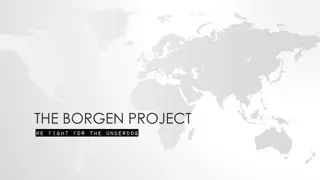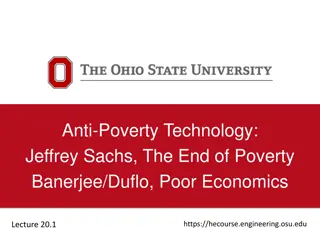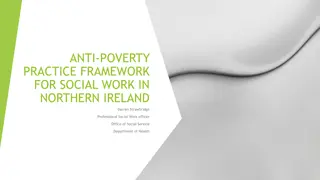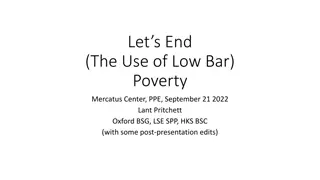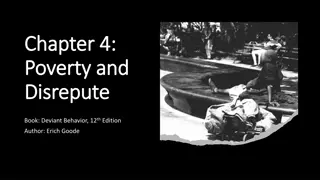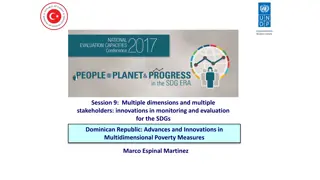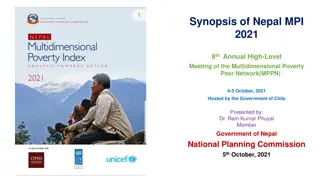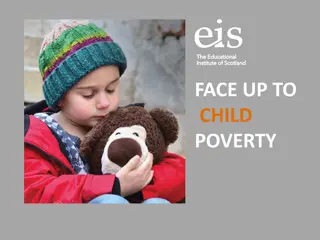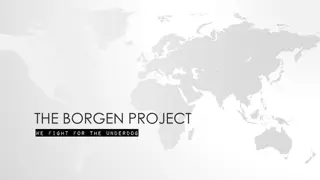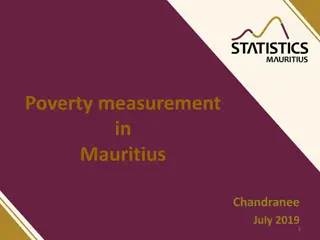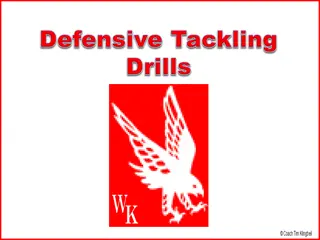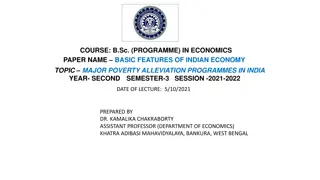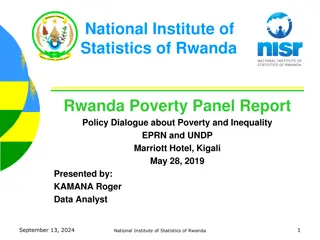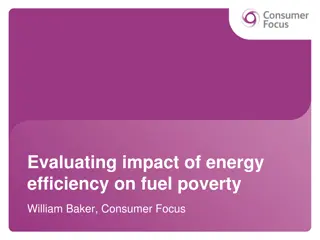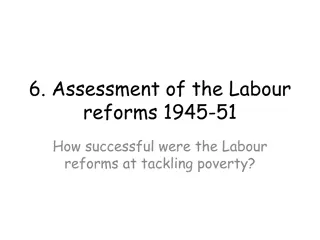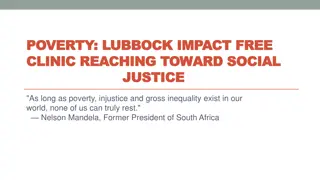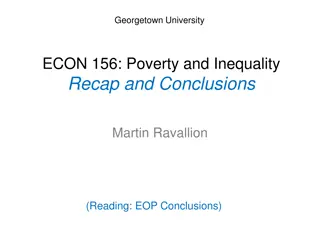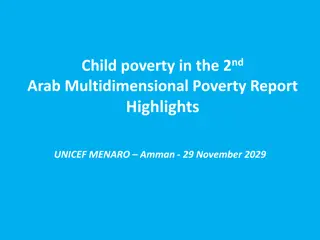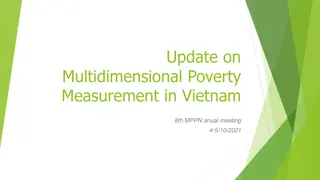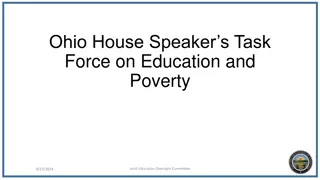Module 8 Tackling Poverty
Explore multidimensional poverty measurement, poverty profiles, ADePT application in poverty analysis, and evidence-based policy strategies. Understand poverty dynamics and effective poverty reduction approaches through case studies and analysis.
Uploaded on Mar 05, 2025 | 0 Views
Download Presentation

Please find below an Image/Link to download the presentation.
The content on the website is provided AS IS for your information and personal use only. It may not be sold, licensed, or shared on other websites without obtaining consent from the author.If you encounter any issues during the download, it is possible that the publisher has removed the file from their server.
You are allowed to download the files provided on this website for personal or commercial use, subject to the condition that they are used lawfully. All files are the property of their respective owners.
The content on the website is provided AS IS for your information and personal use only. It may not be sold, licensed, or shared on other websites without obtaining consent from the author.
E N D
Presentation Transcript
1. Measuring poverty 2. Multidimensional poverty 3. Poverty Dynamics Module 8 Tackling Poverty 4. Panel Data 5. Inference with Panel Data 6. International Poverty Comparisons 7. Vulnerability to Poverty JONATHAN HAUGHTON jhaughton@Suffolk.edu 8. Tackling Poverty APRIL 2020
Outline 1. Poverty Profile 2. ADePT 3. Challenges: a. Education b. Health c. Nutrition d. Microfinance e. Employment guarantee schemes f. Insurance 4. Targeting 5. Tax, spending incidence 2 April 2020 JH: POVERTY MEASUREMENT AND ANALYSIS COURSE
What is a poverty profile? Systematic effort to determine Who the poor are Where the poor are Correlates of poverty Essential input into Poverty Reduction Strategy Papers A prelude to policy Data intensive 3 April 2020 JH: POVERTY MEASUREMENT AND ANALYSIS COURSE
ADePT An application designed to simplify and speed up the production of tables and graphs on poverty and inequality World Bank: 15 poverty assessments annually Now version 6.0; easy to download Next two slides: Sample output, Vietnam Urban Poverty Survey, 2009. Hanoi vs. Ho Chi Minh City Assumes 10,000 dong/person/day poverty line 4 April 2020 JH: POVERTY MEASUREMENT AND ANALYSIS COURSE
Sample ADePT output (1) 5 April 2020 JH: POVERTY MEASUREMENT AND ANALYSIS COURSE
Sample ADePT output (2) 6 April 2020 JH: POVERTY MEASUREMENT AND ANALYSIS COURSE
Poverty Strategy: MKUKUTA in Tanzania National Strategy for Growth and Reduction of Poverty 2005- 2010 Growth and reduction in income poverty: Central Good macroeconomic management, modest inflation, adequate fiscal discipline Improvement in quality of life & social well-being Primary schooling now almost universal, but low quality Governance and accountability Empowerment . Surveys find a lot of corruption Goals OK; monitoring essential ` Needs to be founded on data and analysis 7 April 2020 JH: POVERTY MEASUREMENT AND ANALYSIS COURSE
Evidence-based policy RCTs have become popular e.g. Do flipcharts work in Kenya? Not always possible (e.g. macro policy) External validity often suspect But hope is that accumulation of evidence will guide Two Recent Books Banerjee & Duflo: Poor Economics Karlan and Appel: Beyond Good Intentions 8 April 2020 JH: POVERTY MEASUREMENT AND ANALYSIS COURSE
1. Education Supply encourages enrolment, raises wages Africa: primary enrolment from 54% to 70% (1999-2006) Duflo: Indonesia s school building program Demand sometimes strong Benefits from nudges: Conditional cash transfers (Mexico); cash transfers (Malawi) E.g. for private schools Challenge: improving quality Private vs. public? After-school tutoring? Materials? Absenteeism? Tracking? Information? Computer-assisted learning? All need appraisal. 9 April 2020 JH: POVERTY MEASUREMENT AND ANALYSIS COURSE
2. Health Low-hanging fruit often unpicked. Why? Bed nets reduce malaria. Kenya: $6 cost; $0.75 price kills demand; free helps Oral rehydration Cheap, easy; yet 1.5m children die of diarrhea p.a. Chlorination Automatic with piped water; cheap to add Benefits hard to see; externalities; time inconsistency (so we need nudges e.g. Progresa doctor visits; Mexico piso firme). 10 April 2020 JH: POVERTY MEASUREMENT AND ANALYSIS COURSE
3. Nutrition Food is desirable per se, for health, for work India: % saying they don t have enough food 1983: 17%. China: Jensen & Miller: subsidized staple, less was bought 2004: 2% Why so little attention to micronutrients? Iodine Iron: In fish sauce in Indonesia; $1 p.a., +$46 earn Deworming in Kenya: improves schooling too Effects of fortification hard to see; other priorities 11 April 2020 JH: POVERTY MEASUREMENT AND ANALYSIS COURSE
4. Microfinance Not just microcredit Inherently expensive to lend small sums without collateral Group borrowing can help, but limited Adverse selection, moral hazard are problems Don t oversell: not a panacea Seems to help (Khandker & Pitt on Grameen; Duflo et al. on Spandana in Hyderabad) 12 April 2020 JH: POVERTY MEASUREMENT AND ANALYSIS COURSE
5. Employment guarantees Maharashtra. Started 1965. Low wage. Guaranteed manual work. Reduced poverty severity, but not headcount Originally: Relief operation to ameliorate distress. Can it be a program to fight poverty? India: NREGS. Since 2005. 41m households. How effective? Argentina: Trabajar II (1997) workfare Raised incomes (by half of gross wages paid); 4/5 of beneficiaries from poorest quintile 13 April 2020 JH: POVERTY MEASUREMENT AND ANALYSIS COURSE
6. Insurance Against old age; crop failure; illness Why used so little? E.g. Fewer than 20% in Gujarat, Andhra Pradesh, bought even minimal crop insurance Standard problems: Adverse selection: only bad risks sign up Moral hazard: given insurance, careless Other issues: Government spoiled market? Poor understanding by clients? Trust in provider? Time inconsistency? 14 April 2020 JH: POVERTY MEASUREMENT AND ANALYSIS COURSE
Constructing Social Protection: Indonesia Context: 12% poor (29 million out of 240 million) Next 70 million still vulnerable 2008-2012: Rising inequality Post AFC strategy: Food; jobs; access to health, education; credit for small enterprises. [Basri & Papanek] Political support for targeting poverty 15 April 2020 JH: POVERTY MEASUREMENT AND ANALYSIS COURSE
Social Protection in Indonesia Several programs, poorly coordinated. Rice for poor (RASKIN). Rp13 trn. 25% of population. Scholarships (BSM). Rp19 trn. To rise to 25% of population. Social health assistance for the poor (JAMKESMAS): Rp5 trn. 35% of population. Unconditional cash transfers (BLT): Rp14 trn. [Low support.] Conditional cash transfers (PKH): Rp1 trn in 2009. [Moderate support.] Due to expand to 3m hh by 2014, 6.5m by 2015; now 1.2m. Benefit c. 10%. Does it work? Well targeted? Efficient? PNPM . Cash for work. Self targeting; funds go directly to local body. Cost effective. National Team for the Acceleration of Poverty Reduction (TNP2K), VP. Think tank 16 April 2020 JH: POVERTY MEASUREMENT AND ANALYSIS COURSE
Targeting: Poverty Alleviation in Indonesia Modest programs Targeting not great 17 April 2020 JH: POVERTY MEASUREMENT AND ANALYSIS COURSE
How To Target the Poor Means testing Requires high-quality data Geographical Community-based Local people identify peers who are poor Population groups E.g. Infirm, old Self-targeting E.g. food for work; free 3kg LPG bottles Hybrid: Conditional cash transfers: Mexico: Progresa/Oportunidades [Paul Shultz; rigorous impact evaluation]. Brazil. Bangladesh [Faria Huq] 18 April 2020 JH: POVERTY MEASUREMENT AND ANALYSIS COURSE
Identifying the Poor Poverty mapping: identify poor areas Construct proxy means testing methods By district (n=500); based on detailed survey data Index = f(housing info, assets, hhsize, education, work status, ) Collect data on proxies E.g. 43% of households, 2011; + census data; + local community data. Identify poor, unify database, issue cards. Allow system for appeals; revisions; updates 19 April 2020 JH: POVERTY MEASUREMENT AND ANALYSIS COURSE
Determinants of Poverty 20 April 2020 JH: POVERTY MEASUREMENT AND ANALYSIS COURSE
At Least Get Tax, Spending, Right Fuel subsidies Taxes: which, and at what rates? Spending: how target? Net effects: average incidence Marginal incidence 21 April 2020 JH: POVERTY MEASUREMENT AND ANALYSIS COURSE
Subsidies in Indonesia: Fuel and Electricity Very long history; typical of oil producers But net oil importer since 2004 Some other countries too 2005: >2% GDP in Azerbaijan, Bolivia, Ecuador, Egypt, Indonesia, Jordan, Yemen Large fraction of budget [23% gov rev, 3.7% GDP, 2012] Crowds out other spending, including infrastructure Enough to spook ratings firms: S&Ps cut BB+ from positive to stable on May 3, 2013; stalled reform and weaker external profile . Inefficient Use too much energy But embedded in prices, and investment decisions Weakly targeted Most benefits flow to non-poor 22 April 2020 JH: POVERTY MEASUREMENT AND ANALYSIS COURSE
Distribution of Fuel Subsidies 20 countries, 2005-2009 Direct effect: 2.6% of household consumption; indirect effect, 3.3%. Source: Granado, Coady, and Gillingham. The Unequal Benefits of Fuel Subsidies. IMF, 2010 23 April 2020 JH: POVERTY MEASUREMENT AND ANALYSIS COURSE
Why Fuel Subsidies Persist Problem: High proportion of spending by poor, even if, absolutely, most benefits go to rich. Spending pattern similar to Thailand, for instance see incidence analysis Difficult to undo May 14, 2013: Proposed raising Pgas 33% to Rp6,000/l, Pdiesel 22% to Rp5,500/l. Will add to inflation, which hits in short run (but not long-run). Politically, only replaceable if one can find better ways to target the poor 24 April 2020 JH: POVERTY MEASUREMENT AND ANALYSIS COURSE
Peru: Incidence of All Taxes Figure 13. Incidence of All Taxes, 2000 Taxes/expenditure by expenditure decile Taxes/income by expenditure decile Taxes/income by income decile 40.0 1 6.0 1 4.0 35.0 1 4.0 1 2.0 30.0 1 2.0 1 0.0 25.0 1 0.0 8.0 20.0 8.0 6.0 15.0 6.0 4.0 10.0 4.0 2.0 5.0 2.0 0.0 0.0 0.0 1 2 3 4 5 6 7 8 9 1 0 1 2 3 4 5 6 7 8 9 10 1 2 3 4 5 6 7 8 9 10 Income per capita deciles Expenditure per capita deciles Expenditure per capita deciles Progressive or not? Page 25 April 2020 JH: POVERTY MEASUREMENT AND ANALYSIS COURSE
Peru: State Spending on Education 2000 Figure 10. State Spending on Education, 2000 Education spend./expenditure by expenditure decile Pre-K Education Spending/capita by expenditure decile Education Spending/capita by expenditure decile 25.0 1 8.0 300.0 1 6.0 250.0 20.0 1 4.0 1 2.0 200.0 15.0 1 0.0 150.0 8.0 10.0 6.0 100.0 4.0 5.0 50.0 2.0 0.0 0.0 0.0 1 2 3 4 5 6 7 8 9 10 1 2 3 4 5 6 7 8 9 10 1 2 3 4 5 6 7 8 9 10 Income per capita deciles Income per capita deciles Expenditure per capita deciles Secondary Educn. spending/capita by expend. decile Higher Education Spending/capita by expend. decile Primary Education Spending/capita by expend. decile 200.0 70.0 80.0 180.0 70.0 60.0 160.0 60.0 50.0 140.0 50.0 120.0 40.0 100.0 40.0 30.0 80.0 30.0 60.0 20.0 20.0 40.0 10.0 10.0 20.0 0.0 0.0 0.0 1 2 3 4 5 6 7 8 9 10 1 2 3 4 5 6 7 8 9 10 1 2 3 4 5 6 7 8 9 10 Inco me per capita deciles Inco me per capita deciles Income per capita deciles 26 April 2020 JH: POVERTY MEASUREMENT AND ANALYSIS COURSE
Education Spending Elsewhere 27 April 2020 JH: POVERTY MEASUREMENT AND ANALYSIS COURSE
Social Subsidies in Peru Allocated based on reported usage Page 28 April 2020 JH: POVERTY MEASUREMENT AND ANALYSIS COURSE
Peru: Distribution of Social Subsidies Figure 12. Social Subsidies, 2000 Social Subsidies/expenditure by expenditure decile Social Subsidies/income by expenditure decile Social Subsidies/income by income decile 25.0 50.0 1 6.0 45.0 1 4.0 20.0 40.0 1 2.0 35.0 1 0.0 1 5.0 30.0 8.0 25.0 1 0.0 20.0 6.0 15.0 4.0 5.0 1 0.0 2.0 5.0 0.0 0.0 0.0 1 2 3 4 5 6 7 8 9 10 1 2 3 4 5 6 7 8 9 10 1 2 3 4 5 6 7 8 9 10 Expenditure per capita deciles Expenditure per capita deciles Income per capita deciles Page 29 April 2020 JH: POVERTY MEASUREMENT AND ANALYSIS COURSE
Peru: Taxes Net of Social Spending Figure 16. Taxes Net of Social Spending, 2000 Tax net of spend./expenditure by expenditure decile Tax net of spending/income by expenditure decile Tax net of spending/income by income decile 20.0 20.0 1 5.0 10.0 1 0.0 1 0.0 0.0 5.0 1 2 3 4 5 6 7 8 9 1 0 -10.0 0.0 0.0 1 2 3 4 5 6 7 8 9 10 1 2 3 4 5 6 7 8 9 1 0 -20.0 -5.0 -1 0.0 -30.0 -1 0.0 -40.0 -20.0 -1 5.0 -50.0 -20.0 -30.0 -60.0 -25.0 -70.0 -40.0 -30.0 Income per capita deciles Expenditure per capita deciles Expenditure per capita deciles System seems progressive overall But Some taxes not included (e.g. CIT) Not all spending can be included Rely on our incidence assumptions Page 30 April 2020 JH: POVERTY MEASUREMENT AND ANALYSIS COURSE
Peru: Marginal Incidence: Raise VAT by 1% 2000: assume VAT from 18% to 19% Of extra revenue: Education takes 7.6% Health takes 7.3% Social subsidies take 28.4% Remaining spending not allocable Page 31 April 2020 JH: POVERTY MEASUREMENT AND ANALYSIS COURSE
Figure 18. The Effects of a One Percentage Point Increase in VAT with Associated Social Spending Change in Tax net of spending, S/., by expenditure decile, with higher VAT & spending Tax net of spending, S/., by expenditure decile 2,500.00 Higher VAT and spending 50.00 2,000.00 40.00 Initial position 1 ,500.00 30.00 1 ,000.00 20.00 500.00 1 0.00 - - 1 2 3 4 5 6 7 8 9 1 11 1 2 3 4 5 6 7 8 9 10 (500.00) (1 0.00) Expenditure per capita deciles Expenditure per capita deciles Change in Tax net of spending, S/., by income decile, with higher VAT & spending Tax net of spending, S/., by income decile 2,500.00 Higher VAT and spending 45.00 40.00 2,000.00 35.00 Initial position 30.00 1 ,500.00 25.00 20.00 1 ,000.00 1 5.00 1 0.00 500.00 5.00 - - 1 2 3 4 5 6 7 8 9 10 1 2 3 4 5 6 7 8 9 10 (5.00) (1 0.00) (500.00) Income per capita deciles Income per capita deciles Page 32 April 2020 JH: POVERTY MEASUREMENT AND ANALYSIS COURSE
Trump, Clinton tax proposals 33 April 2020 JH: POVERTY MEASUREMENT AND ANALYSIS COURSE
Notes on the Reading Jonathan Haughton & Shahidur Khandker (2013), Notes on Tackling Poverty. Haughton & Khandker (2009), Handbook, chapter 15. This covers tax and benefit incidence. Abhijit Banerjee & Esther Duflo. 2011. Poor Economics: A Radical Rethinking of the Way to Fight Global Poverty. PublicAffairs. An excellent treatment of microeconomic and practical approaches, rooted in the use of RCTs. Dean Karlan & Jacob Appel. 2011. More Than Good Intentions: How a New Economics is Helping to Solve Global Poverty. Dutton. Often paired with the Banerjee/Duflo book; covers many similar topics, but more breezily written. World Bank. ADePT Software Platform. http://surveys.worldbank.org/adept 34 April 2020 JH: POVERTY MEASUREMENT AND ANALYSIS COURSE



